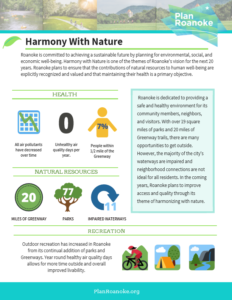What should Roanoke look like in 20 years?
Every 20 years or so, City planners gather ideas and feedback from the community and develop a new Comprehensive Plan. This document helps guide policy decisions and future investments in the City. The most important step in the process is collaborating with community members to determine priorities.
Ways to get involved:
We’re looking to collaborate with community members to identify Roanoke’s strengths, weaknesses, opportunities, and challenges. We want to hear from as many community members as possible. In August, we hosted 10 community Open House meetings at locations across the City and more than 200 community members attended to share their ideas. We also received 1,218 online responses to our Comprehensive Plan survey, which closed on Oct. 18. In early Fall of 2018, we formed citizen working groups and will continue to meet through the winter to discuss specific goals, policies, and actions that the community feels should be incorporated into the City’s next 20-year plan.
Roanoke has developed six guiding themes to direct Plan 2040. These themes will help to ensure the City’s commitment to achieving a sustainable future by planning for environmental, social, and economic well-being for community members and visitors alike. Each Fact Sheet helps to define theme components and the resources Roanoke currently has to provide for each theme. Citizen working groups were formed in Fall 2018. These groups will help the City of Roanoke’s Planning team describe desired conditions, translate ideas into policies and actions, and work together to validate or modify elements of a draft Comprehensive Plan.

Executive Summary
City Plan 2040 is taking shape. The following summary outlines the priorities and policies identified through public outreach. These policies will be refined in the final phases of the planning process to identify action items and ensure consistency.
Community Response Report
Between July and October, the City hosted ten public meetings and launched an online survey to gather feedback and ideas from Roanoke community members. The following report summarizes the feedback that the city received through that outreach process.
Peer Cities Assessment
In preparation for Plan 2040, it is important to visualize Roanoke’s status. Performance was measured along metrics correlated to Plan 2040’s six guiding Themes in order to understand Roanoke’s standing among its peers. The Peer Cities Assessment helps to identify areas where Roanoke is performing well, and areas of improvement.
State and National Comparison
This comparison provides a quick snapshot of how Roanoke is performing compared to state and national numbers. This reference guide provides an overview of how Roanoke measures in vital city demographics, such as educational attainment, income, and diversity.
Mapping Exercise
Where are Roanoke’s strengths? Where are areas that can be improved? Please take a minute to add your feedback to this interactive map.
How it works:
Click the link below to go to an interactive map exercise. Plot green dots to identify strengths in Roanoke, yellow dots to identify opportunities for improvement, and red dots to identify the City’s challenges. You can add optional comments to give more context to your feedback. If you have any questions or trouble using the map, please email Wayne Leftwich at wayne.leftwich@roanokeva.gov or call 540-853-1104.




